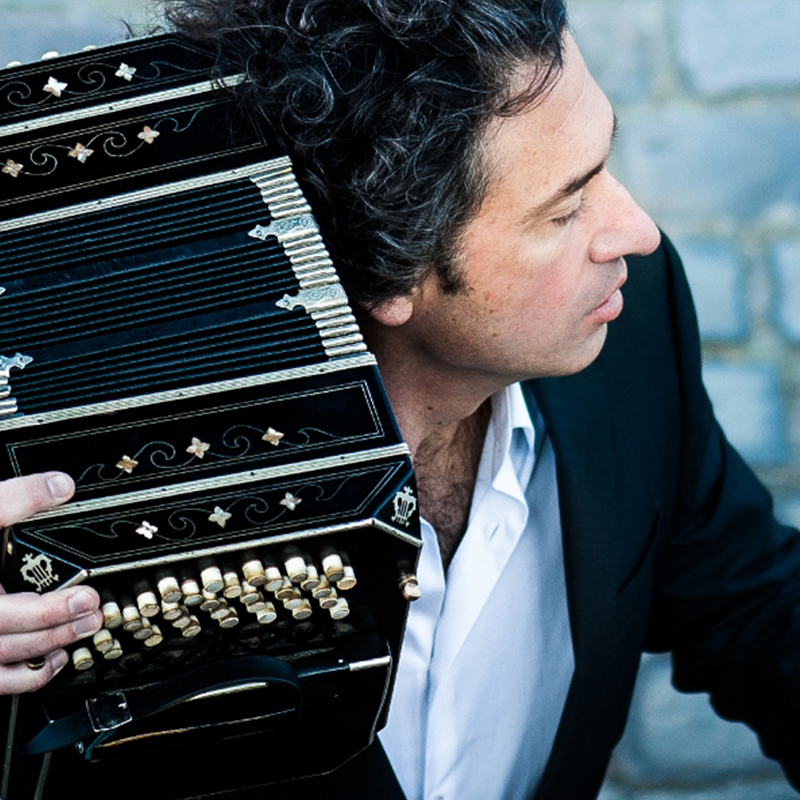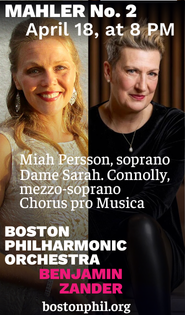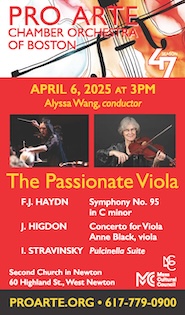Pro Arte Orchestra explores the world of Piazzolla and the bandoneon

Astor Piazzolla explored modern harmonies and extended forms with his tango ensembles, bringing a new expressiveness to the music of his native Argentina. His tango-infused compositions in turn expanded the rhythmic and melodic vocabulary of the classical repertoire.
Pro Arte Chamber Orchestra of Boston and conductor Gisèle Ben-Dor celebrated Piazzolla’s distinct legacy in their own unique program on Sunday at Sanders Theatre. “Nuevo Tango” featured guest soloist Juanjo Mosalini in works by Piazzolla as well as premieres of the bandoneonist’s own compositions and transcriptions of Piazzolla’s music.
The bandoneon—relative of the much-maligned accordion—is rarely heard in orchestral settings. Yet it is synonymous with both Argentinian music and the late Piazzolla’s own performances.
Piazzolla’s Aconagua, Concerto for Bandoneon was the final work on the program but the most powerful performance of the afternoon. Piazzolla’s publisher titled the 1979 concerto after the highest mountain peak in the western hemisphere to signify it as the summit of the composer’s work.
Piazzolla studied with the likes of Nadia Boulanger and Alberto Ginastera, and Aconagua synthesizes that expert handling of harmony, counterpoint, and other compositional techniques with the diverse themes, moods, and rhythms of tango Piazzolla played and lived his whole life. The concerto is scored for chamber orchestra with percussion including piano and harp, and comprises two intense outer movements surrounding a wistful middle section.
Pro Arte burst into the opening Allegro marcato with bold declaratory phrases. The augmented instrumentation strengthened orchestral textures while clarifying the rhythmic profile. Ben-Dor patiently expanded the central Moderato from a morose reflection into a throbbing outburst. Orchestral entrances behind the soloist stayed gentle and flowing. The conductor also maintained a driving clip in the final Presto. A slow seductive ground rhythm emerged, with the string players striking the fingerboards and backs of their instruments, before a roaring march closed a concerto that earned applause after each movement.
Mosalini demonstrated the dexterity and passion of a concert virtuoso throughout. His tender a cappella asides in the first movement and undulating phrases in the second felt like warm serenades. In the Presto, Mosalini’s crisp phrase endings and drawling slides between notes made for a clever and convincing dramatic compromise between the movement’s anxious first section and lazy second theme.
Sunday also marked the world premiere of Mosalini’s arrangement of Piazzolla’s The Four Seasons of Buenos Aires. An homage to Vivaldi’s Four Seasons transplanted to the capital of Piazzolla’s homeland, these “seasons” were composed at different points between 1965 and 1970. He would perform them with his quintet but rarely together. Mosalini’s version not only makes the bandoneon a soloist, but it connects the four separate works into one lengthy and intense tour.
“Summer” started the work with an earthy feel. Mosalini leaned into sour crushes of notes on top of the string’s pop and thrust, with Ben-Dor’s slight push bringing out the melodic side of the accompaniment. Finely articulated phrases from both Mosalini and principal cellist Steven Laven marked the peaceful moments of “Autumn” and “Winter.” Yet scratchy glissandos, anxious tremolos and the string players knocking catchy beats on their instruments were a thread throughout Mosalini’s long suite. “Spring” packed soloist and ensemble alongside one another in close contrapuntal phrases. With the bandoneon’s wider timbre and louder volume, the effect was less differentiated. The angular minor key groove still came through.
Other parts of the program emphasized harmony and texture over rhythm. Toma Toca, Mosalini’s tribute to a guitarist colleague, began with a swirling orchestra before rapid-fire bandoneon licks over a reiterated pizzicato dance rhythm. The overall feel was of a controlled exhibition tango rather than a visceral nightclub outing, heightened by a cool glaze of violins in the middle.
Creaking dissonant strings introduced Mosalini’s Cien Años, a commission by Ben-Dor for Pro Arte heard in its world premiere on Sunday. Based on a sad motif that seems to climb only to inevitably fall, Mosalini’s organ-like tones and syncopated pumps over Argentine milonga and tango accents unveiled a varied timbral palette. Unfortunately, Mosalini’s arrangement of Piazzolla’ Libertango could have used a stronger bass line to underpin the infectious theme, even with the incisive violins and rich, rhythmic bandoneon chords.
A grateful capacity crowd coaxed two encores—presumably also Mosalini’s arrangements—from the musicians. Ben-Dor introduced them through their connections to film. French Argentine tango artist Carlos Gardel’s “Por un Cabeza” (from Scent of a Woman) is an audacious, strutting tango seemingly tailormade for a cinematic dance number. Piazzolla’s “Oblivion,” used in the Italian film Henry IV, made for an ironic follow-up and concert closer. It’s a meandering and utterly melancholy meditation on madness, performed with suitable reflectiveness by Pro Arte and Mosalini.
Pro Arte will next perform works by Strauss, Britten and Brahms 8 p.m. March 21 at First Baptist Church, Newton. proarte.org; 617-779-0900
Posted in Performances

